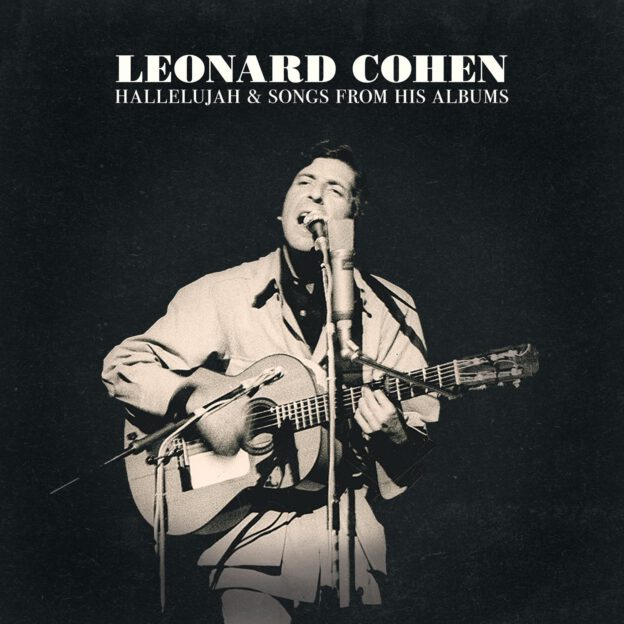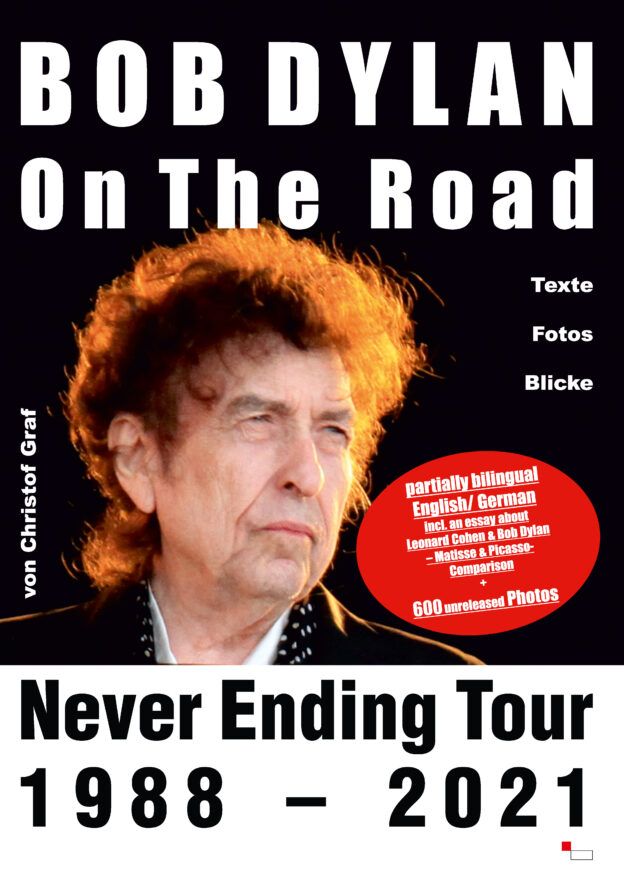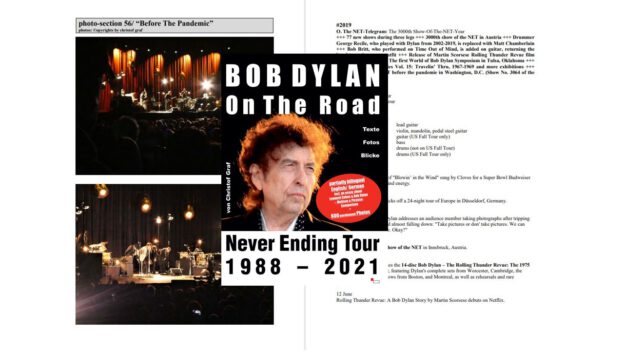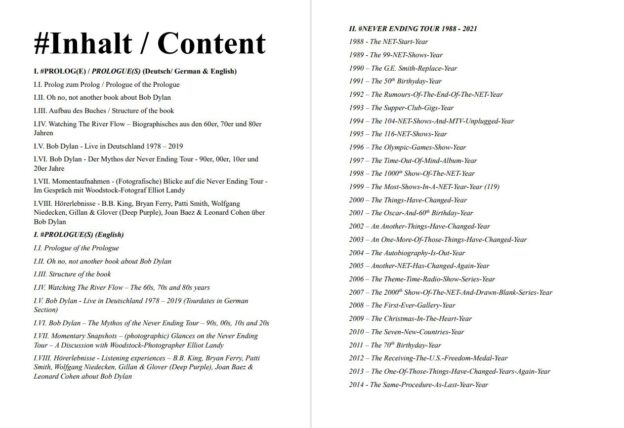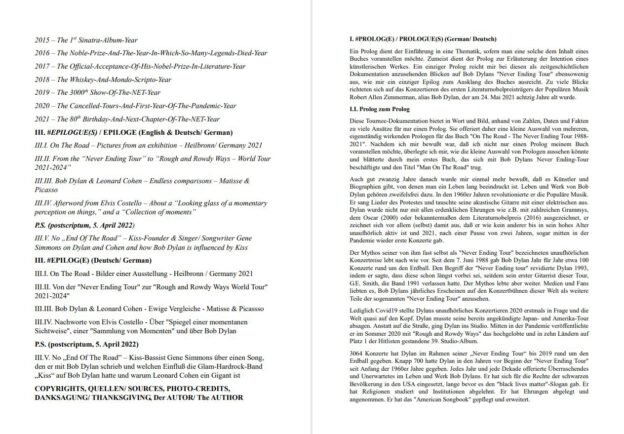
Elegische Zeitreise als Momentaufnahme – Bob Dylan in Krefeld 2022
von Christof Graf
Im Westen nichts Neues! – Oder doch? Mit diesen beiden Sätzen könnte man das letzte von sechs Bob Dylan-Konzerten in Deutschland 2022 beschreiben. Die Erwartung an die hohe Qualität von Dylans musikalischen Darbietungen der „Rough And Rowdy Ways Tour 2021-2024“ war ihm seit dem Europa-Tour-Start in Oslo und den Konzerten in Flensburg, Magdeburg und Berlin vorausgeeilt. Sie wurde auch in Krefeld bestätigt. Um es gleich vorwegzunehmen: An der sich seit Anbeginn der diesjährigen Europatournee und seit Aufnahme seiner Konzertaktivitäten Ende 2021 in Amerika kaum verändernden Setlist hat sich auch in der Krefelder Eishockey-Arena nichts verändert.
Dylan eröffnet mit einem groovenden Cowboy-Rock-artigen „Watching The River Flow“ und verabschiedet sich mit der Hymne „Every Grain Of Sand“. Dazwischen präsentiert er neun von zehn Songs des während der Pandemie veröffentlichten Masterpieces „Rough And Rowdy Ways“. Bis auf das 17-Minuten-Epos „Murder Most Foul“ sind alle Songs davon zu hören. Dazwischen sind ältere Lieder wie z.B. „Gotta Serve Somebody“ oder „When I Paint My Masterpiece“ zu hören. Nein, ein Best-Of-Konzert hat es von Dylan noch nie gegeben, auch 2022 in Krefeld nicht. Ja, „The Times Are A-Changin“ spielt er auch nicht, macht aber an Vielem deutlich, daß sich eben diese geändert haben.
Auf die Diskussion, ob die 1988 begonnene „Never Ending Tour“ mit der Zwangspause der Pandemie nach Dylans letzter Konzertreise vor der Pandemie 2019 dann doch als beendet anzusehen ist, lässt man sich nicht ein. Die Frage, ob das von ihm selbst als „Rough And Rowdy Ways Tour 2021-2024“ proklamierte Konzertieren tatsächlich ein Neubeginn oder nur ein weiteres Kapitel in der Geschichte ist, läßt man offen. (Einige der Feuilletonisten verwenden in ihrer aktuellen Berichterstattung tatsächlich noch den Begriff der „Never Ending Tour“.) Veränderung, Kontrast zum Einstigen und überhaupt das Deklarieren von Menetekel der Jetztzeit sind das derzeitige Anliegen von Bob Dylan auch beim Krefelder Konzert.
Verändert hat sich auch die Konzertatmosphäre und die Attitude des Künstlers.
Kurz nach 20.00 Uhr, nach dem kurzen Intro klassischer Musik, erlischt das Saallicht. Einen Moment später sitzt Dylan geradezu versteckt hinter dem Klavier. Es ist mit schwarzem Samt bezogen. Wenn er sitzen bleibt, sieht man ihn kaum. Zum Singen steht er auf. Dann erkennt man zumindest Kopf und Haare. Bühnen-Requisiten gibt es auch kaum. Die einstigen früheren Hollywood-Studio-Scheinwerfer sind Vergangenheit. Die Oscar-Statue gibt es auch nicht mehr. Der Vorhang im Hintergrund wird mit gelben oder rotem Licht eingetaucht. Nichts hat abzulenken von der Präsenz Dylans. Seine fünf musikalischen Mitstreiter tragen ebenso wie Dylan selbst schwarze Anzüge. Der Bühnenboden der „Rough And Rowdy Ways-Tour“ ist in grelles weißes Licht getunkt. Das Ambiente wirkt dezent, spärlich und unaufdringlich, um die Aufmerksamkeit auf Dylans Wort und Klänge zu fokussieren. Doch zunächst spielen sich Dylan & Band noch ein, nähern sich, finden sich von Song zu Song. „Most Likely You Go Your Way (and I`ll Go Mine)” zeigt die Richtung ebenso wie Dylans Bekenntnis “I Contain Multitudes”. Nach “When I Paint My Masterpiece” krächzt Dylan ein wohlformuliertes “Thank You” ins Publikum. Das Publikum bedankt sich nach der jahrelangen Non-Kommunikation des Meisters mit sofortigem Applaus. Es werden noch zwei weitere „Thank Yous“ im Laufe des Abends folgen. Nach „Black Rider“ steht Dylan kurz auf und macht drei zögerliche Schritte in die Bühnenmitte. Für zwei Sekunden hält er sich am Mikrofonständer fest. Er tippelt zurück zum schützenden Klavier. Dylans körperliche Zerbrechlichkeit wird sichtbar. Seine Schritte sind langsam und zögerlich. Stimme und Klavier sind dagegen omnipräsent und manifestieren seine Relevanz als Singer/ Songwriter und Literat.
Die Konzertatmosphäre hat fast etwas religiöses. Dylan ist nicht mehr nur Storyteller, sondern Wegbegleiter. Er ist Prediger und Lieferant vom Soundtrack unseres Lebens. Die Andacht wirkt elegisch, episch, eindringlich, schwermütig und aufrüttelnd.
Bei „Black Rider“ fühlt man sich ein wenig an Leonard Cohen, den anderen großen Singer/ Songwriter und an dessen Requiem „You Want It Darker“ kurz vor dessen Tod 2016, erinnert. Bei Dylan scheint der „schwarze Reiter“ noch nicht halt zu machen, auch wenn sich Dylan mit ihm zu beschäftigen scheint.
Dylan und Band vertreiben die Dunkelheit mit einem ebenso dunklen „My Own Version Of You“ und mit einem lasziven „I`ll Be Your Baby Tonight“. Dylan spielt erstmals an diesem Abend Mundharmonika. Ein Bedrohlichkeit beschreibendes „Crossing The Rubicon“ folgt. Er interagiert mit Gitarrist Doug Lancio, neigt sich ihm zu, ebenso wie er zwei mal mit einer Handbewegung den zweiten Gitarristen Bob Britt zum „Leise sein“ auffordert. Dylan liebt es in Krefeld zu phrasieren und ist mit den Ergebnissen zufrieden. Sein Gesang ist klar, laut und deutlich. Seine Erzählungen entwickeln sich.
Dylan geht danach wieder fragil zur Bühnenmitte. Eine willkommene wie ungewohnte, zugleich ein wenig Besorgnis erregende Geste.
Dylan ist es auf dieser Tour wichtig, sein aktuelles Album vorzutragen. Ablenkungen sind unerwünscht. Smartphones wurden zuvor weggeschlossen. Das Konzert wirkt wie eine Melange aus kirchlicher Andacht eines Predigers, der seinen Jüngern die Leviten liest und aus einer Vorlesung eines Literaturprofessors, der einfach nur die Macht des Wortes beherrscht. Zudem gibt sich Dylan als Maler sprachlicher Bilder, wenn er für Sekunden Text und Musik inne halten lässt. Die Worte standen manchmal wie alleine im Raum. Dylan machte die zu 80 % gefüllte Eishockey-Arena zur Kirche voller Leinwände. Er liess bei der etwa 3000-Seelen-Gemeinde sekundöse Stille entstehen. „Key West“ hatte solche Momente zu Beginn des letzten Konzertdrittels ebenso wie das bluesige „False Prophet“ im ersten Drittel des Konzertes.
Bei „Gotta Serve Somebody“ griff Bob Britt zur E-Gitarre und es wurde schneller und lauter. Am Ende finalisierte Dylan den Song mit den gesprochenen Worten: „Everybody has to serve somebody, …. Even me“. An dieser Stelle sagte mein Sitznachbar: “Leonard Cohen hätte es vielleicht etwas demütiger mit den Worten „Even You“ oder „me too“ gesagt. Für Dylan war es demütig genug.
Demütig und konzentriert waren auch der neue Schlagzeuger Charley Drayton und die einzigen aus „Never Ending Tour“-Zeiten verbliebenen Tony Garnier am Bass und Donnie Herron an Violine, Pedal Steel and Lap Steel. Das Quintett klingt von Song zu Song perfekter. Tony Garnier ist für Dylan so etwas, wie es Roscoe Beck bei Leonard Cohen war. Eine Art musikalischer Direktor, der auf Dylans Stimmungen, Unmut und Freude wie ein Raubvogel auf seine Beute lauert, um Dylan mit musikalischer Gefälligkeit zu begegnen.
Leonard Cohen hat am Ende seiner Schaffensperiode von „Old Ideas“ und „Popular Problems“ gesprochen. Danach hat er 2016 gefragt, ob man es „dunkler haben wolle“, bevor er 2019 posthum „Thanks For The Dance“ sagte. Dylan scheint 2022 noch eine Menge neue Ideen zu haben und über unpopuläre Probleme auf rauhen Wegen sprechen zu wollen.
Konzertkritiken wurden Bob Dylan-Konzerten noch nie gerecht. Dylan war es stets egal, was Kritiker meinten. Seine jetzige Altersmilde reichte in Krefeld für drei „Thankyous“ für die ihm entgegengebrachte Aufmerksamkeit. Nach dem „Goodbye Jimmy Reed“-Blues stellt Dylan seine Musiker vor. Ein Novum im Gegensatz vergangener Jahre. Zugaben gibt es nicht. Nur noch „Every Grain Of Sand“ vom 1981er „Shot Of Love”-Album. Dann stellen sich die Musiker zusammen mit Dylan wieder nur für Sekunden in der Bühnenmitte auf. Standing Ovations! Die elegische Zeitreise als Momentaufnahme ist vorbei. Dylan und Band verschwinden im selben Schwarz aus dem sie knapp 100 Minuten zuvor herausgetreten sind. Die Andacht ist zu Ende und jeder weiß: „Things Have Changed“. Wohl jenen, die dabei sein konnten.
Elegische Zeitreise as a Snapshot – Bob Dylan in Krefeld 2022 (engl. version translated by google)
by Christof Graf
Nothing new in the West! – Or is it? With these words one could describe the last of six Bob Dylan concerts in Germany in 2022. The expectation of the high quality of Dylan’s musical performances of the „Rough And Rowdy Ways Tour 2021-2024“ had preceded him since the start of the European tour in Oslo and the concerts in Flensburg, Magdeburg and Berlin. It was also confirmed in Krefeld. To anticipate it right away: The setlist, which has hardly changed since the beginning of this year’s European tour and since the start of his concertactivities in America at the end of 2021, has not changed in the Krefeld Ice Hockey Arena.
Dylan opens with a grooving cowboy-rock-like „Watching The River Flow“ and says goodbye with the anthem „Every Grain Of Sand“. In between, he presents nine out of ten songs from the masterpiece „Rough And Rowdy Ways“, released during the pandemic. Except for the 17-minute epic „Murder Most Foul“ all songs can be heard. In between, older songs such as „Gotta Serve Somebody“ or „When I Paint My Masterpiece“ can be heard. No, there has never been a best-of concert by Dylan, not even in Krefeld in 2022. Yes, he doesn’t play „The Times Are A-Changin“ either, but he makes it clear in many things that these have changed.
The discussion as to wether the „Never Ending Tour“, which began in 1988 with the forced break of the pandemic after Dylan’s last concert tour before the pandemic, should be regarded as over in 2019 is not to be accepted. The question of wether the concert proclaimed by himself as the „Rough And Rowdy Ways Tour 2021-2024“ is actually a new beginning or just another chapter in history is left open. (Some of the feuilletonists use in their current reporting actually still the term „Never Ending Tour“. ) Change, contrast to the former and in general the declaration of Menetekel of the present time are the current concern of Bob Dylan also at the Krefeld concert.
The concert atmosphere and the attitude of the artist has also changed.
Shortly after 20.00 o’clock, after the short intro of classical music, the light goes out. A moment later, Dylan is almost hidden behind the piano. It is covered with black velvet. If he stays seated, you can hardly see him. He gets up to sing. Then you can at least recognize head and hair. There are hardly any stage props. The former Hollywood studio lights are a thing of the past. The Oscar statue also no longer exists. The foreground in the background is bathed with yellow or red light. Nothing distracts from Dylan’s presence. His five musical comrades-in-arms wear black suits, as does Dylan himself. The stage floor of the „Rough And Rowdy Ways Tour“ is dipped in bright white light. The ambience is subtle, sparse and unobtrusive to focus attention on Dylan’s word and clichés. But first Dylan & Band play each other, get closer, find each other from song to song. „Most Likely You Go Your Way (and I’ll Go Mine)“ shows the direction, as does Dylan’s confession „I Contain Multitudes“. After „When I Paint My Masterpiece“ Dylan croaks a „Thank You“ into the audience. The audience thanks the master with immediate applause after years of non-communication. There will be two more „Thank Yous“ in the course of the evening. After „Black Rider“, Dylan gets up briefly and takes three hesitant steps into the middle of the stage. For two seconds, he holds on to the microphonestand. He taps back to the protective piano. Dylan’s physical fragility becomes visible. His steps are slow and hesitant. Voice and piano, on the other hand, are omnipresent and manifest its relevance as a singer/songwriter and writer.
The concert atmosphere has something almost religious. Dylan is no longer just a storyteller, but a companion. He is a preacher and supplier of the soundtrack of our lives. The devotional is elegiac, epic, haunting, melancholy and stirring.
With „Black Rider“ you feel a little reminded of Leonard Cohen, the other great singer/songwriter and his requiem „You Want It Darker“ shortly before his death in 2016. The „black rider“ does not seem to stop at Dylan, even if Dylan seems to be dealing with him.
Dylan and band drive away the darkness with an equally dark „My Own Version Of You“ and a lascivious „I’ll Be Your Baby Tonight“. Dylan plays harmonica for the first time this evening. A threatening „Crossing The Rubicon“ follows. He interacts with guitarist Doug Lancio, leans towards him, just as he twice asks the second guitarist Bob Britt to „be quiet“ with a wave of his hand. Dylan loves to phrase in Krefeld and is satisfied with the results. His singing is clear, loud and distinct. His stories are evolving.
Dylan then goes again fragile to the middle of the stage. A welcome and unusual gesture, but at the same time a little worrying.
It is important for Dylan on this tour to present his current album. Distractions are undesirable. Smartphones were previously locked away. The concert looks like a melange of church devotion by a preacher who reads the Levites to his disciples and a lecture by a literature professor who simply masters the power of the word. In addition, Dylan presents himself as a painter of linguistic images when he lets text and music pause for seconds. The words sometimes stood alone in the room. Dylan turned the 80% filled hockey arena into a church full of mental screens. He created seconds of silence in the community of about 3000 souls. „Key West“ had such moments at the beginning of the last third of the concert as well as the bluesy „False Prophet“ in the first third of the concert.
On „Gotta Serve Somebody“ Bob Britt grabbed his electric guitar and it got faster and louder. At the end, Dylan finalized the song with the spoken words: „Everybody has to serve somebody, …. Even me“. At this point, my seat neighbor said, „Leonard Cohen might have said it a little more humbly with the words „Even You“ or „me too.“ For Dylan, it was humble enough.
Humble and focused were also the new drummer Charley Drayton and the only remaining from „Never Ending Tour“ times Tony Garnier on bass and Donnie Herron on violin, pedal steel and lap steel. The quintet sounds more perfect from song to song. Tony Garnier is to Dylan something like Roscoe Beck was to Leonard Cohen. A kind of musical director who waits on Dylan’s moods, displeasure and joy like an eagle on his prey to meet Dylan with musical favor.
Leonard Cohen spoke of „Old Ideas“ and „Popular Problems“ at the end of his creative period. After that, he asked in 2016 if they wanted it to be „darker“ before saying „Thanks For The Dance“ (2019) posthumously. Dylan still seems to have a lot of new ideas in 2022 and wants to talk about unpopular problems in rough ways.
Dylan always didn’t care what critics meant. His current mildness of age was enough in Krefeld for three „Thankyous“ for the attention he received. After the „Goodbye Jimmy Reed“ blues, Dylan introduces his musicians. A novelty in contrast to previous years. There are no encores. Only „Every Grain Of Sand“ from the 1981 „Shot Of Love“ album. Then the musicians line up together with Dylan again only for seconds in the middle of the stage. Standing Ovations! The elegiac journey through time as a snapshot is over. Dylan and the band disappear in the same black from which they stepped out for almost 100 minutes. The devotional is over and everyone knows: „Things Have Changed“. Probably those who could be there.
More about the NET:
Vol. 12 – Bob Dylan – On The Road – Never Ending Tour 1988 – 2021

